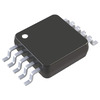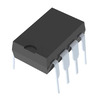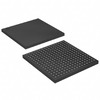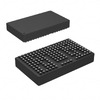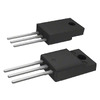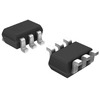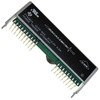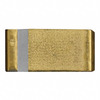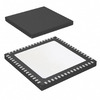A Complete Guide to the ATMEGA16U2 Microcontroller
The ATMEGA16U2 microcontroller is a versatile component that plays a major role in embedded systems, offering a range of pins with specialized functions. This microcontroller is highly adaptable, enabling applications that span from simple digital interactions to complex analog and PWM tasks. In this article, we’ll dive into the specific functions of each pin, their physical layout, and how they contribute to effective circuit design. With insights into digital, analog, communication, and reset functionalities, you’ll gain a deeper understanding of how to integrate the ATMEGA16U2 into your projects for enhanced control and efficiency.Catalog
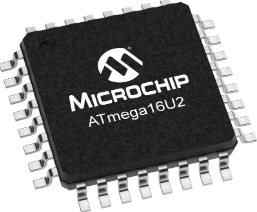
Pinout
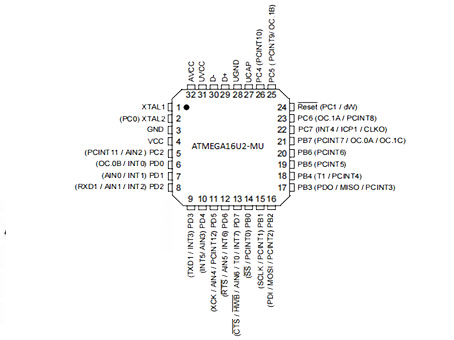
CAD Model
Symbol
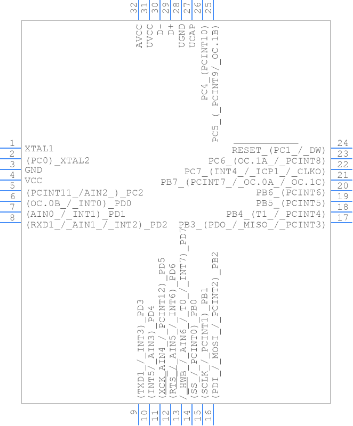
Footprint
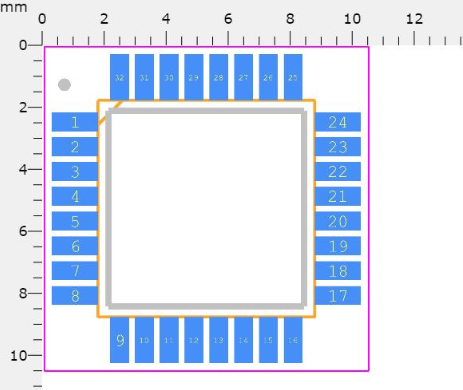
3D Model
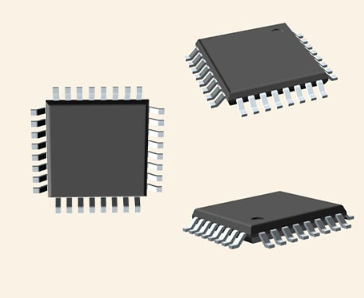
Overview of ATmega16U2
The ATmega16U2 is an 8-bit microcontroller known for its low power consumption and adaptability due to the AVR enhanced RISC architecture. This design allows complex instructions to be processed within a single clock cycle, enabling impressive performance that can reach approximately 1 MIPS per MHz. This balance of power efficiency and processing speed facilitates diverse applications, especially where minimizing energy use is a priority.
Exploring the architecture further, the AVR's capability for single-cycle instruction execution enables you to write highly efficient code. This proves advantageous in contexts that demand rapid decision-making, such as embedded automotive systems or actual controls. The simplicity of the instruction set not only boosts performance but also eases the programming process. Consequently, you can often experience a more manageable learning curve with the ATmega16U2, accelerating the pace of innovation and creation.
Technical Specifications
Here is the table presenting the technical specifications, attributes, and parameters for Microchip Technology ATMEGA16U2-AU.
|
Type |
Parameter |
|
Factory Lead Time |
10 Weeks |
|
Contact Plating |
Tin |
|
Mount |
Surface Mount |
|
Mounting Type |
Surface Mount |
|
Package / Case |
32-TQFP |
|
Number of Pins |
32 |
|
Number of I/Os |
22 |
|
Watchdog Timers |
Yes |
|
Operating Temperature |
-40°C ~ 85°C (TA) |
|
Packaging |
Tray |
|
Series |
AVR® ATmega |
|
Published |
2007 |
|
JESD-609 Code |
e3 |
|
Pbfree Code |
Yes |
|
Part Status |
Active |
|
Moisture Sensitivity Level (MSL) |
3 (168 Hours) |
|
Number of Terminations |
32 |
|
Terminal Position |
QUAD |
|
Terminal Form |
GULL WING |
|
Peak Reflow Temperature (°C) |
260 |
|
Supply Voltage |
5V |
|
Terminal Pitch |
0.8mm |
|
Frequency |
16MHz |
|
Time @ Peak Reflow Temp (s) |
40 |
|
Base Part Number |
ATMEGA16U2 |
|
Qualification Status |
Not Qualified |
|
Interface |
SPI, Serial, UART, USART, USB |
|
Memory Size |
16kB |
|
Oscillator Type |
Internal |
|
RAM Size |
512 x 8 |
|
Voltage - Supply (Vcc/Vdd) |
2.7V ~ 5.5V |
|
uPs/uCs/Peripheral ICs Type |
Microcontroller, RISC |
|
Core Processor |
AVR |
|
Peripherals |
Brown-out Detect/Reset, POR, PWM, WDT |
|
Program Memory Type |
FLASH |
|
Core Size |
8-Bit |
|
Program Memory Size |
16KB (8K x 16) |
|
Connectivity |
SPI, UART/USART, USB |
|
Bit Size |
8 |
|
Has ADC |
No |
|
DMA Channels |
No |
|
Data Bus Width |
8b |
|
DAC Channels |
No |
|
Number of Timers/Counters |
2 |
|
EEPROM Size |
512 x 8 |
|
Number of PWM Channels |
5 |
|
Number of SPI Channels |
1 |
|
Height |
1.05mm |
|
Length |
7mm |
|
Width |
7mm |
|
REACH SVHC |
No SVHC |
|
RoHS Status |
RoHS3 Compliant |
|
Lead Free |
Lead Free |
Components with Similar Specifications
|
Part Number |
ATMEGA16U2-AU |
AT90USB162-16AUR |
ATMEGA8U2-AU |
ATMEGA8U2-AUR |
|
Manufacturer |
Microchip Technology |
Microchip Technology |
Microchip Technology |
Microchip Technology |
|
Package / Case |
32-TQFP |
32-TQFP |
32-TQFP |
32-TQFP |
|
Number of Pins |
32 |
32 |
32 |
32 |
|
Data Bus Width |
8 b |
8 b |
8 b |
8 b |
|
Number of I/O |
22 |
22 |
22 |
22 |
|
Interface |
SPI, Serial, UART, USART, USB |
SPI, UART, USART, USB |
EBI/EMI, SPI, UART, USART, USB |
EBI/EMI, SPI, UART, USART, USB |
|
Memory Size |
16 kB |
8 kB |
16 kB |
8 kB |
|
Supply Voltage |
5 V |
5 V |
4.5 V |
- |
|
Peripherals |
Brown-out Detect/Reset, Power-on Reset, Programmable I/O |
Brown-out Detect/Reset, Power-on Reset, Programmable I/O |
Brown-out Detect/Reset, Power-on Reset, Programmable I/O |
Brown-out Detect/Reset, Power-on Reset, Programmable I/O |
Features
|
Feature
Category |
Details |
|
Core |
High Performance, Low Power AVR® 8-Bit Microcontroller |
|
Architecture |
Advanced RISC Architecture |
|
- 125 Powerful Instructions – Most Single Clock Cycle
Execution |
|
|
- 32 x 8 General Purpose Working Registers |
|
|
- Fully Static Operation |
|
|
- Up to 16 MIPS Throughput at 16 MHz |
|
|
Memory |
- 8K/16K/32K Bytes of In-System Self-Programmable Flash |
|
- 512/512/1024 EEPROM |
|
|
- 512/512/1024 Internal SRAM |
|
|
- Write/Erase Cycles: 10,000 Flash/100,000 EEPROM |
|
|
- Data Retention: 20 years at 85°C / 100 years at 25°C |
|
|
- Optional Boot Code Section with Independent Lock Bits |
|
|
- In-system programming by on-chip Boot Program |
|
|
- True Read-While-Write Operation |
|
|
- Programming Lock for Software Security |
|
|
USB Module |
- USB 2.0 Full-speed Device Module |
|
- Complies fully with Universal Serial Bus Specification
REV 2.0 |
|
|
- 48 MHz PLL for Full-speed Bus Operation (12 Mbit/s) |
|
|
- 176 bytes USB DPRAM for endpoint memory allocation |
|
|
- Endpoint 0 for Control Transfers (8 to 64 bytes) |
|
|
- 4 Programmable Endpoints |
|
|
- IN or OUT Directions |
|
|
- Bulk, Interrupt, and Isochronous Transfers |
|
|
- Programmable maximum packet size (8 to 64 bytes) |
|
|
- Programmable single or double buffer |
|
|
- Suspend/Resume Interrupts |
|
|
- Microcontroller reset on USB Bus Reset |
|
|
- USB Bus Disconnection on Microcontroller Request |
|
|
Peripheral Features |
- One 8-bit Timer/Counter with Separate Prescaler and
Compare Mode (two 8-bit PWM channels) |
|
- One 16-bit Timer/Counter with Prescaler, Compare and
Capture Mode (three 8-bit PWM channels) |
|
|
- USART with SPI master-only mode and hardware flow
control (RTS/CTS) |
|
|
- Master/Slave SPI Serial Interface |
|
|
- Programmable Watchdog Timer with Separate On-chip
Oscillator |
|
|
- On-chip Analog Comparator |
|
|
- Interrupt and Wake-up on Pin Change |
|
|
Debugging |
On-Chip Debug Interface (debugWIRE) |
|
Special Features |
- Power-On Reset and Programmable Brown-out Detection |
|
- Internal Calibrated Oscillator |
|
|
- External and Internal Interrupt Sources |
|
|
- Five Sleep Modes: Idle, Power-save, Power-down,
Standby, and Extended Standby |
|
|
I/O and Packages |
- 22 Programmable I/O Lines |
|
- QFN32 (5x5mm) / TQFP32 Packages |
|
|
Operating Voltage |
2.7 - 5.5V |
|
Operating Temperature |
Industrial (-40°C to +85°C) |
|
Maximum Frequency |
- 8 MHz at 2.7V (Industrial range) |
|
- 16 MHz at 4.5V (Industrial range) |
Block Diagram

Advantages
The ATmega16U2 microcontroller stands out for its remarkable power efficiency, delivering high functionality while consuming minimal energy. This quality makes it exceptionally suitable for portable and battery-operated devices, catering to those who value longevity and convenience. Built on cutting-edge memory technology, the microcontroller aims for optimal performance with an emphasis on reducing unnecessary power loss. Such a feature is mostly appealing for applications that require enduring operation, allowing devices to function over long periods without the hassle of frequent recharging or changing power sources.
Support for community-driven development adds another compelling layer to the ATmega16U2's advantages. Equipped with a robust bootloader, the system enables seamless updates to applications, ensuring ongoing operations are not disrupted. A vibrant global community fuels an extensive ecosystem of software libraries and development tools, expediting the prototyping process and the rollout of innovative solutions. This collaborative environment nurtures the exchange of knowledge and resources, providing everyday perceptions that enrich and elevate application development.
At the core of the ATmega16U2 lies an integrated RISC CPU alongside ISP Flash memory, granting it an unmatched versatility that caters to a wide range of embedded systems. This integration empowers the microcontroller to undertake complex computing tasks while ensuring straightforward programming and execution. The architecture is specifically designed to manage computationally demanding operations and multitasking, which play a dynamic role in various applications—spanning from consumer electronics that enhance daily experiences to industrial automation that drives efficiency and productivity in the workforce.
Package
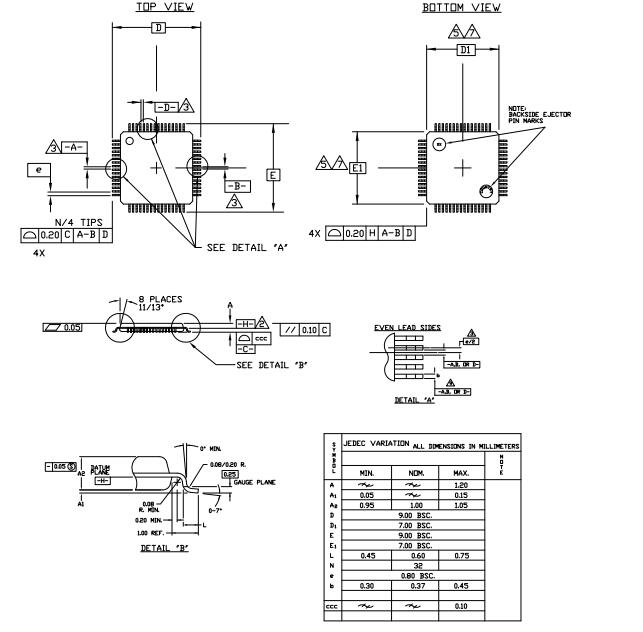
Manufacturer
Microchip Technology Inc. emerges as a prominent force in embedded control solutions, reflecting a dedication to innovation that goes beyond its vast selection of development tools and offerings. The organization boasts a sturdy infrastructure designed for streamlined design processes, effectively facilitating the implementation of products across a variety of sectors. Operating from its headquarters in Chandler, Arizona, Microchip proudly serves over 120,000 clients globally, highlighting its substantial influence and reputation across numerous industries.
The landscape of embedded control has transformed intensely, with innovative enterprises like Microchip leading the charge in these technological strides. Their diverse portfolio encompasses microcontrollers as well as an extensive selection of peripherals, all aimed at augmenting overall system capabilities. This rich collection empowers you to customize solutions tailored to their specific needs, paving the way for the development of applications that span a wide spectrum—from consumer electronics to industrial automation.
Datasheet PDF
ATMEGA16U2-AU Datasheets:
AT90USB162-16AUR Datasheets:
ATMEGA8U2-AU Datasheets:
ATMEGA8U2-AUR Datasheets:
About us
ALLELCO LIMITED
Read more
Quick inquiry
Please send an inquiry, we will respond immediately.
Frequently Asked Questions [FAQ]
1. What is ATMEGA16U2?
The ATmega16U2 is a low-power, 8-bit CMOS microcontroller built on AVR-enhanced RISC architecture. This design is precisely crafted to maximize power efficiency and processing speed, achieving close to 1 MIPS per MHz. Its architecture lends itself to versatile applications across various fields, from embedded systems to IoT devices. Notably, the ATmega16U2's efficient power consumption plays a substantial role in prolonging the life of battery-operated devices. The interplay between performance and power efficiency mirrors broader trends in microcontroller technology, where the goal is to reduce energy use without compromising on speed. This balance can influence modern design practices, especially in terms of sustainability.
2. How many pins does the ATMEGA16U2 have?
The device features 32 pins dedicated to a wide range of input/output functions. These pins are active interfaces for linking the microcontroller to other components, including sensors and actuators. Having a well-thought-out pin configuration can significantly enhance the design of complex systems, leading to better operational efficiency. For instance, strategic pin allocation allows for seamless multitasking and boosts overall system responsiveness. Experience shows that focusing on pin assignments early in the development process can avert potential design constraints, emphasizing thoughtful planning during project execution.
3. What support is available for the ATMEGA16U2?
The ATmega16U2 is supported by a diverse collection of development tools, which include C compilers, debuggers, in-circuit emulators, and evaluation kits that aid in program and system development. Utilizing these resources can considerably speed up the development timeline and boost productivity, fostering an iterative design approach. Noteworthy is the practical use of these tools in debugging and code optimization, a strategy that has proven used for managing the intricacies of embedded programming. The synergy of software and hardware resources emphasizes a comprehensive development approach, where using extensive toolsets leads to innovative and effective solutions. Embracing such practices can deepen the understanding of system performance and pave the way for future advancements in technology design.

Comprehensive Guide to TDA7377 Audio Amplifier
on November 15th

Comprehensive Guide to the LM2577 Voltage Regulator
on November 15th
Popular Posts
-

What is GND in the circuit?
on January 1th 3246
-

RJ-45 Connector Guide: RJ-45 Connector Color Codes, Wiring Schemes, R-J45 Applications, RJ-45 Datasheets
on January 1th 2793
-

Understanding Power Supply Voltages in Electronics VCC, VDD, VEE, VSS, and GND
on November 19th 2593
-

Fiber Connector Types: SC Vs LC And LC Vs MTP
on January 1th 2249
-

Comparison Between DB9 and RS232
on January 1th 1866
-

What Is An LR44 Battery?
Electricity, that ubiquitous force, quietly permeates every aspect of our daily lives, from trivial gadgets to life-threatening medical equipment, it plays a silent role. However, truly grasping this energy, especially how to store and efficiently output it, is no easy task. It is against this background that this article will focus on a type of coin cell battery that may seem insignificant on the...on January 1th 1835
-

Understanding the Fundamentals:Inductance Resistance, andCapacitance
In the intricate dance of electrical engineering, a trio of fundamental elements takes center stage: inductance, resistance, and capacitance. Each bears unique traits that dictate the dynamic rhythms of electronic circuits. Here, we embark on a journey to decipher the complexities of these components, to uncover their distinct roles and practical uses within the vast electrical orchestra. Inductan...on January 1th 1789
-

What Is RF and Why Do We Use It?
Radio Frequency (RF) technology is a key part of modern wireless communication, enabling data transmission over long distances without physical connections. This article delves into the basics of RF, explaining how electromagnetic radiation (EMR) makes RF communication possible. We will explore the principles of EMR, the creation and control of RF signals, and their wide-ranging uses. The article ...on January 1th 1776
-

CR2430 Battery Comprehensive Guide: Specifications, Applications and Comparison to CR2032 Batteries
What is CR2430 battery ?Benefits of CR2430 BatteriesNormCR2430 Battery ApplicationsCR2430 EquivalentCR2430 VS CR2032Battery CR2430 SizeWhat to look for when buying the CR2430 and equivalentsData Sheet PDFFrequently Asked Questions Batteries are the heart of small electronic devices. Among the many types available, coin cells play a crucial role, commonly found in calculators, remote controls, and ...on January 1th 1772
-

Comprehensive guide to hFE in transistors
Transistors are crucial components in modern electronic devices, enabling signal amplification and control. This article delves into the knowledge surrounding hFE, including how to select a transistor's hFE value, how to find hFE, and the gain of different types of transistors. Through our exploration of hFE, we gain a deeper understanding of how transistors work and their role in electronic circu...on November 19th 1759

